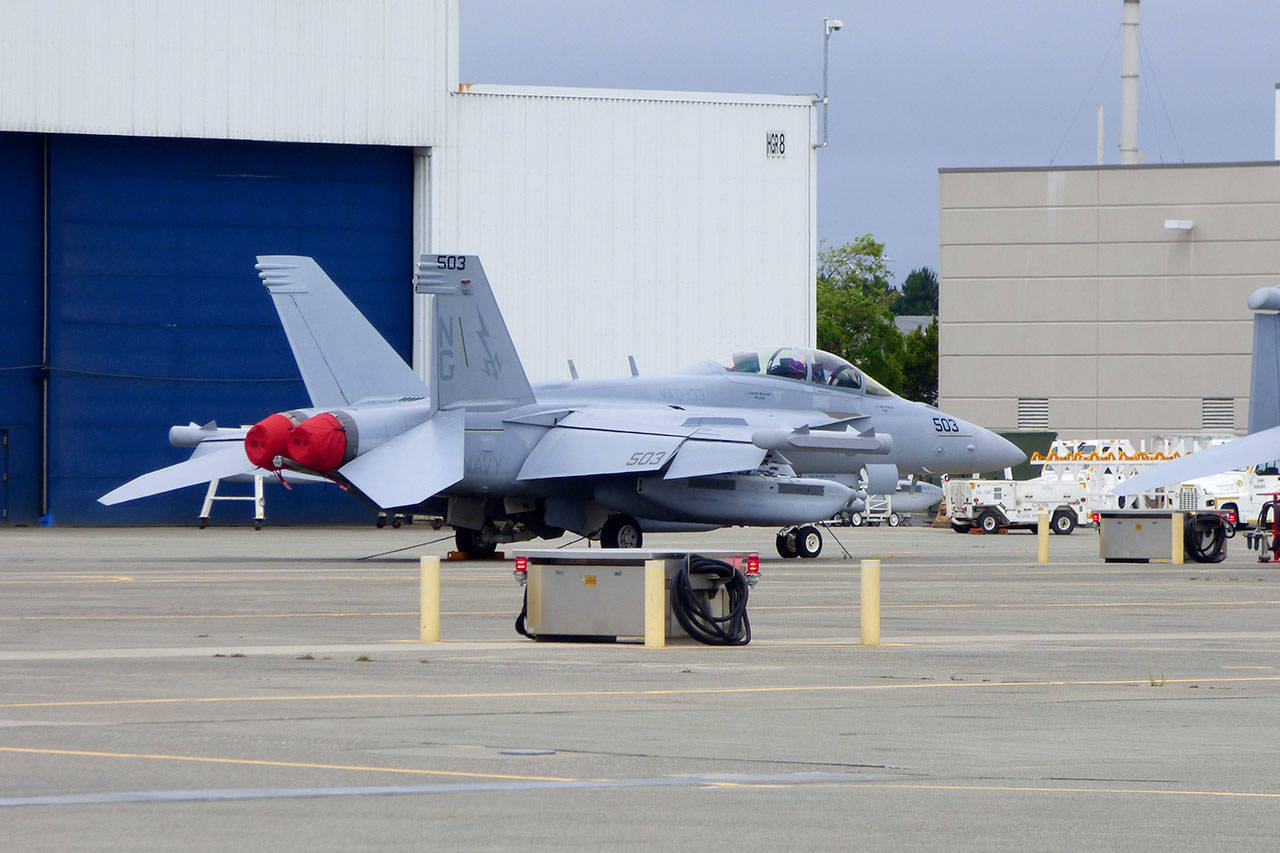NAVAL AIR STATION WHIDBEY ISLAND — The Navy will add 36 EA-18G Growlers to its operations at Naval Air Station Whidbey Island and increase landing practice at the Outlying Landing Field in Coupeville by 2022.
The Navy filed on Wednesday the record of decision that it will use the preferred alternative identified in its environmental impact statement in June 2018 with no changes.
The record of decision was filed a few days after Secretary of the Navy Richard Spencer declined recommendations from the federal Advisory Council on Historic Preservation to continue to measure jet noise on historic properties on Ebey’s Landing National Historical Reserve.
It says that an estimated 112,100 Growler operations will occur annually, with 88,000 at the Ault Field base on North Whidbey and 24,100 at OLF Coupeville, which is at the southern end of the island across Admiralty Inlet from Port Townsend.
Each operation is defined as either a takeoff or landing, so that translates to 12,050 touch-and-go flights at OLF Coupeville.
“Additional personnel and additional aircraft will be in place at NAS in the 2022 time frame,” said Ted Brown, environmental public affairs officer for U.S. Fleet Forces Command.
“Between now and then, personnel will arrive and new aviators will begin the training process and the Growlers will be flying.”
Brown said 628 Navy personnel — primarily aviators and maintenance personnel — will be added at the base.
The additional number of family members scheduled to be in the area totals 860.
Many residents of Port Townsend and others on the North Olympic Peninsula have protested the Navy’s plans since 2013, citing increased noise from the Growlers. Port Townsend residents were not invited to participate in negotiations about noise impacts.
“They aren’t considered a direct impact, and yet the noise is all around us,” Port Townsend City Manager David Timmons has said.
The Sound Defense Alliance on Whidbey Island has scheduled a meeting in Port Townsend at 6 p.m. March 21 at the Northwest Maritime Center, 431 Water St., as one of several regional meetings to discuss how to achieve a better balance between the military and civilian communities, the group said.
“In the past the Navy has been a good partner,” said Maryon Attwood, chair of the Sound Defense Alliance, after the Navy’s final decision was released.
“But across the region, our elected officials, community leaders and citizens all agree that this proposal is just asking too much from our part of Washington. We are not only disappointed, we are outraged.
“We will not be collateral damage to this expansion directed from Washington, D.C. We are committed to continuing to work with our elected officials and people across the state and nation to get the Navy to listen and to achieve a better and sustainable outcome.”
The Navy said in its announcement of the decision that that the action will expand its expeditionary and carrier capabilities by establishing two new expeditionary squadrons, adding two additional aircraft and additional squadron personnel to each of the nine existing carrier squadrons, and augmenting the fleet replacement squadron with eight additional aircraft and additional squadron personnel.
Other aircraft operations will continue from Naval Air Station Whidbey Island, including P-8A Poseidon Surveillance aircraft, P-3C Orion anti-submarine warfare patrol aircraft, EP-3 reconnaissance aircraft, MH-60 Seahawk helicopter and other transient aircraft.
Navy officials said in the press release that they considered a number of factors, including strategic and operational importance of augmenting our nation’s electronic attack capabilities, ensuring quality of pilot training, and balancing the impacts of the proposed action on the human and natural environment.
Of the 15 combinations of alternatives and scenarios analyzed in the Final Environmental Impact Statement, the Navy said the chosen alternative impacts fewer people overall living in the surrounding communities based on an estimated number of people living within the 65 dB DNL (Day-Night Average Sound Level) or greater noise contour it has used as a guideline.
This measure represents the total accumulation of all sound energy, but spread out uniformly over a 24-hour period.
The majority of operations will be performed at OLF Coupeville because it provides more realistic training for aviators, the Navy said. Officials said the site best replicates the aircraft carrier landing pattern for aviators since it is on a 200-foot ridge surrounded by flat terrain, similar to an aircraft carrier operating on water.
The Navy said it plans to invest in new technologies to reduce aircraft engine noise and will implement “precision landing mode” (Magic Carpet) to reduce overall numbers of landing practices.
A copy of the record of decision is available on the Navy’s Growler Environmental Impact Statement website at www.whidbeyeis.com.
________
Jefferson County Editor/Reporter Jeannie McMacken can be reached at 360-385-2335 or at jmcmacken@peninsuladailynews.com.

